【第七十一回目】
秋色庵 大坂家:粋で優しい看板娘のいる和菓子店
| セインさん、今日は港区三田にある和菓子の老舗「秋色庵 大坂家」さんです。 Thayne-san, today we’re at Shushiki-an Osaka-ya, a traditional confectioners in Mita in the Minato-ku area of Tokyo. |
|
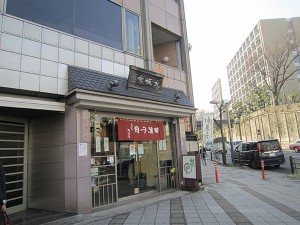 Shushiki-an Osaka-ya, Shushiki-an Osaka-ya, |
|
| 慶應義塾大学の目の前、そして東京タワーが、すぐそこに見えるロケーションがすごいですね。それにしても「大坂家」というのは、大阪から来たお店なのでしょうか。 This is a great location. We’re right in front of Keio University, and there’s Tokyo Tower just over there. It’s called Osaka-ya, so I presume they’re from Osaka? |
|
| ご先祖様が大阪の人だったようです。江戸に出てきて、和菓子屋さんとして創業されたのが元禄時代(1688~1703)。江戸時代の史料にも名を残す名店で、いまのご当主が18代目です。 I think their ancestors were from Osaka. They came to Edo and established the shop in the Genroku Period (1688 – 1703). It’s a well-known store whose name appears in historical records. The present proprietor is the eighteenth generation. |
|
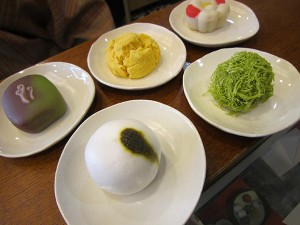 Various spring treats Various spring treats |
|
| (倉本) | ようこそ、セインさん。大坂家の倉本です。 Thayne-san, welcome. I’m Kuramoto from the Osaka-ya. |
| こんにちは、倉本さん。和菓子っていいですね。すばらしい! Hello Kuramoto-san. Wagashi is indeed really nice. That’s truly amazing ! |
|
| (倉本) | ありがとうございます。 Thank you very much. |
| お店は創業から300年以上も続いておられるとか。ずっとこの場所ですか? It’s more than 300 years since your store was established, isn’t it? Has the store always been in this location? |
|
| (倉本) | 創業の地は、現在の日本橋小網町です。当時は「大坂家 伊勢大掾(いせだいじょう)」という名前で、古い史料などには「伊勢大掾」としてよく出てきます。おかげさまで繁盛して店が続いていったのですが、明治27年(1894)、15代目・私の曽祖父の時代にもらい火で焼け出されまして、芝の金杉橋へ移転。そこで再起をはかったのですが、大正12年(1923)に今度は関東大震災に遭って再び店が焼失。そこで16代目、私の祖父が心機一転をはかって移ってきたのが、この場所です。店名を「大坂家」としたのも祖父です。 Actually, the store was established in what is now Nihonbashi Koamicho. At that time, the store was named Osaka-ya Isedaijou, but it was often called Isedaijou in historical records. We’ve been very fortunate to be able to continue to stay in business. But in 1894, during the time of my great-grandfather, the 15th generation master, the store burnt down and we moved to Kanasugi-bashi in Shiba. We started to make a comeback, but the store was once again destroyed by fire in the Great Kanto Earthquake of 1923. After that, my grandfather, the 16th generation master, decided to make a fresh start and move to this location. The person who changed the name to Osaka-ya was also my grandfather. |
| 「伊勢大掾」に代わって、現在は「秋色庵(しゅうしきあん)大坂家」という名前ですね。きれいな名前ですが、この「秋色」というのは? You changed from Isedaijou and now your store is called Shushiki-an Osaka-ya. It’s a lovely name, but what does Shushiki (Autumn colors) refer to? |
|
| (倉本) | 2代目の娘・お秋の俳号なんです。幼い頃から、松尾芭蕉の第一の門弟と言われた宝井其角(たからいきかく)から俳諧を学んでいたのですが、13歳で詠んだ 「井戸端の 桜あぶなし 酒の酔」 という俳句が親王様の目にとまって江戸中の大評判となりました。 The second generation master’s daughter, named Oaki(pen name), was a haiku poet. From when she was young, she studied poetry under Takarai Kikaku, the first disciple of Matsuo Basho, and at the age of 13, she wrote a poem that caught the attention of an Imperial Prince and became popular during the Edo Period: There next to the well, Cherry blossoms may not last, The tipsy nearby. |
| セインさん。しかも、その秋色さんは、大名屋敷に招かれた帰り道、自分のために下賜された駕籠に父親を乗せ、自分は降りて歩いたという親孝行なお嬢さんで、そのエピソードがまた大評判となって、錦絵に描かれたり、講談「秋色桜」になったりしているんです。 Once, when the young poet, Shushiki was invited to a feudal lord’s mansion, she let her father ride the palanquin ordered for her and walked instead. This example of filial piety became a very famous episode and was turned into a wood-block print. In re-tellings of the story, she became known as Shushiki-Zakura. |
|
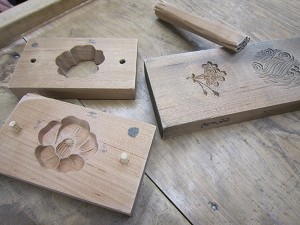 Various wooden moulds for shaping wagashi Various wooden moulds for shaping wagashi |
|
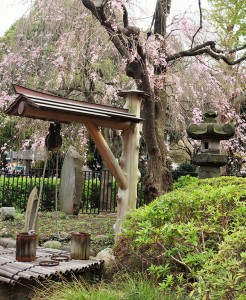 Shushiki-Zakura.(Cherry blossoms)in Ueno Park Shushiki-Zakura.(Cherry blossoms)in Ueno Park |
|
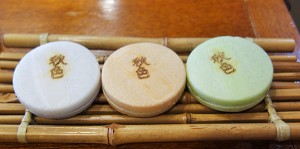 The famous wagashi “Shushiki-Monaka” named after the story of Shushiki The famous wagashi “Shushiki-Monaka” named after the story of Shushiki |
|
| お店の屋号には、いろんな意味が含まれていたんですね。 ところで、ご主人の隣におられる方は? Your store name is made up of a lot of different meanings. By the way, who is this next to you? |
|
| (倉本) | 3女の朋実です。旦那さんと共に、この店の未来をつくっていってくれるようです。 This is my third daughter, Tomomi. She’s going to take over this store with her husband in the future. |
| すばらしい! 朋実さんは自分からやりたいとおっしゃったんですか? Oh, great! Tomomi-san, did you decide for yourself to take over the store? |
|
| (朋実さん) | はい。ものを作る仕事が好きだったんです。昔も、そして今も。 Yes. I’ve always liked making things, both now and in the past. |
| では、天職ですね! It must be your calling! |
|
| ええ。 セインさん、もし良かったらちょっと和菓子作りを体験してみますか? I think so. Thayne-san, would you like to try making wagashi? |
|
| ほんとー! でも、僕ができるかなあ…。 Sure! But I’m not sure I can do it… |
|
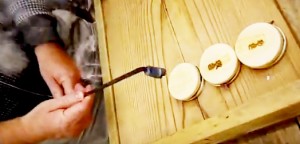 I was allowed to try burning the emblem into the monaka. I was allowed to try burning the emblem into the monaka. |
|
| 動画はこちら | |
| 緊張しました! 簡単な作業かと思ったんだけど、まっすぐに押せてないし、押しすぎて焦げたりして、あまりきれいな焼印ではないですね。 I was nervous! I thought it looked easy, but I didn’t do it very straight and I pushed a little too hard so it got burnt. It didn’t turn out very nice. |
|
| (倉本) | はい。売り物にはなりません。(笑)。 That’s right, we won’t be able to sell this one, haha. |
| でも、和菓子作りの楽しさに触れることができました。お店の奥の工場にまで通していただいてありがとうございました。 But I was able to experience making wagashi. Thank you for letting me into the factory part of the shop. |
|
| 本当に清潔感にあふれていて、甘い匂いなどもしないので驚きました。 和菓子づくりで大事にされていることは何ですか? It was full of a sense of freshness, and I was surprised that there weren’t any sweet smells. What’s the most important thing when making wagashi? |
|
| (倉本) | 第一に、よい材料を使うこと。業者任せではだめです。もちろんどの業者さんとも長い間に信頼関係を築いてきたけれど、それでも毎回、ちゃんとチェックしながら最上のものを使うようにしています。 The first thing is to use good ingredients. We can’t leave it up to the vendor. Of course we’ve built up good relationships with vendors over the years, but we still carefully check the ingredients every time to make we are always using the best possible. 第二には、自分が作っているものを好きになること。仕事が好きでなければ、そして作っているお菓子が好きでなければ、続きません。 そして最後は、店の規模を守ること。目の行き届く規模のなかで昔の情緒を残したお菓子を丁寧に作っていきたいと思っています。もちろん、時代に取り残されないように現代をきちんと感じながらね。 |
| いいお話をありがとうございました。温かなご家族の雰囲気も伝わって、なんだか今日は幸せな気持ちになりました。和菓子っていいですね。 Thank you for the interesting conversation. Your place really has a warm family atmosphere, and I’ve really enjoyed meeting you. |
|
| ありがとうございました。 Thank you very much. |
|
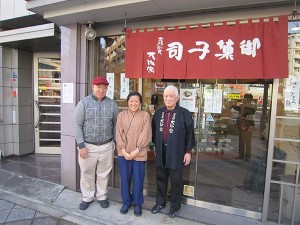 |
|
| http://www.o-sakaya.com/syuushiki/more.html | |
| (文)太田美代 (英訳)デイビッド・A・セイン |
 1959年、米国生まれ。証券会社勤務を経て来日し、翻訳・通訳など多岐にわたって活躍。豊富な教授経験を生かし、数多くの英語関係書籍を執筆。近著に『日本人のチョットへんな英語』(アスコム)、『超入門シャドーイング』(主婦の友社)、日本人が使いすぎる英語(PHP文庫)など多数。 下町の魅力に魅了され、自身が代表を務める英語関連のコンテンツ会社のエートゥーゼットのオフィスを根津に構えている。英会話本の執筆をしながら、東京・文京区根津と春日にあるエートゥーゼット英語学校の校長も務める。 http://www.smartenglish.co.jp/
1959年、米国生まれ。証券会社勤務を経て来日し、翻訳・通訳など多岐にわたって活躍。豊富な教授経験を生かし、数多くの英語関係書籍を執筆。近著に『日本人のチョットへんな英語』(アスコム)、『超入門シャドーイング』(主婦の友社)、日本人が使いすぎる英語(PHP文庫)など多数。 下町の魅力に魅了され、自身が代表を務める英語関連のコンテンツ会社のエートゥーゼットのオフィスを根津に構えている。英会話本の執筆をしながら、東京・文京区根津と春日にあるエートゥーゼット英語学校の校長も務める。 http://www.smartenglish.co.jp/







